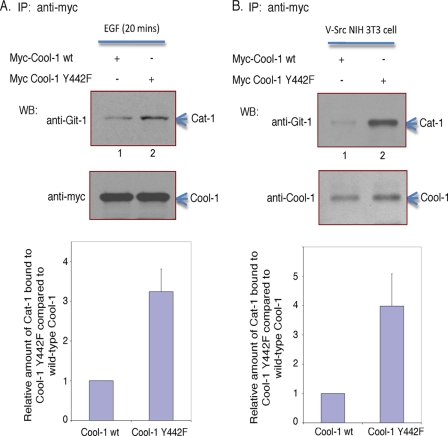FIGURE 6.
Conditions leading to the phosphorylation of Cool-1 decreases its ability to associate with Cat. A, NIH 3T3 cells transfected with either Myc-tagged wild-type Cool-1 or the Cool-1 Y442F mutant were serum-starved for 15 h, and then stimulated with EGF for 20 min. Myc-tagged Cool-1 was immunoprecipitated with anti-Myc antibody and the immunocomplexes were probed with an anti-Git-1 (Cat-1) antibody (top panel) and with an anti-Myc antibody (middle panel). The amount of Cat-1 that co-immunoprecipitated (co-IPed) with Myc-Cool-1 was quantified by densitometry using ImageJ (bottom panel). B, viral-Src-transformed NIH 3T3 cells were transfected with wild-type Myc-tagged Cool-1 or the Cool-1 Y442F mutant. Myc-tagged Cool-1 was immunoprecipitated with anti-Myc antibody and the immunocomplexes were probed with an anti-Git-1 (Cat-1) antibody and with an anti-Cool-1 antibody (top panel). The increased amount of Cat-1 that co-IPed with Myc-Cool-1 Y442F compared with Myc-Cool-1 was quantified by densitometry using ImageJ (bottom panel). The results shown in A and B are representative of three experiments, each, with the increased co-immunoprecipitation of endogenous Cat-1 with Cool-1 Y442F ranging from 2–5-fold. Shown is the average increase and standard deviation determined from these experiments.

